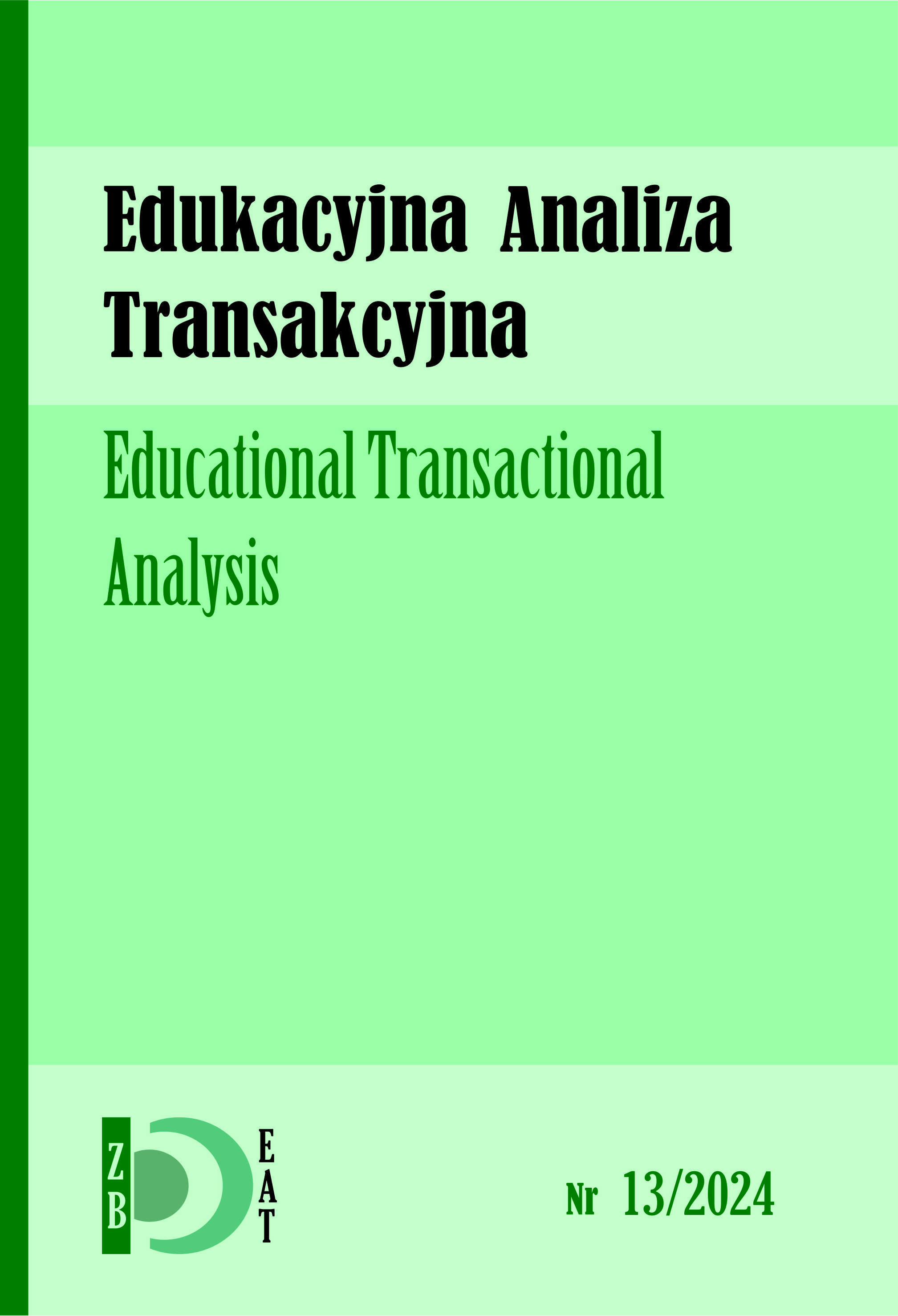Interdisciplinarity , disability and inclusion: knowing to educate
DOI:
https://doi.org/10.16926/eat.2024.13.21Słowa kluczowe:
Słowa kluczowe: interdyscyplinarność; transdyscyplinarność; aktywacja neuronów; trening poznawczo-motoryczny; włączenieAbstrakt
Interdyscyplinarność, niepełnosprawność i inkluzja: wiedza w służbie edukacj
Niniejszy artykuł analizuje instytucję interdyscyplinarności w kontekście Treningu Poznawczo-Motorycznego, wykorzystując narzędzia epistemiczne do refleksji nad zagadnieniami związanymi z interdyscyplinarnością, niepełnosprawnością, włączeniem oraz koncepcją "Wiedzieć, aby edukować". Celem badania jest refleksja nad: a) złożoną siecią, która wspiera włączenie i ewolucję naukową; b) epistemologicznymi aspektami ożywiania złożonego procesu poznawczego; c) sposobem, w jaki transdyscyplinarność łączy neuroaktywację, Trening Poznawczo-Motoryczny i włączenie, wyrażonym aforyzmem "Wiedzieć, aby edukować". W szczególności podkreślono potrzebę istnienia złożonego podłoża epistemicznego, które umożliwi dynamizację transdyscyplinarności w wymiarze inkluzywnym, nieodłącznie związanym z procesem humanizacji
Downloads
Bibliografia
Anderson, K., & Meyer, J. (2017). Interdisciplinarity and inclusion: Promoting the diversity of knowledge and people. Interdisciplinary Journal Studies, 2(1), 45-58.
Banks, J. A., et al. (2008). Interdisciplinary learning: Process and results. Educational Research Quarterly, 31(3), 36-47.
Choi, M., & Rainey, H. G. (2010). Promote organizational inclusion settings: A multilevel approach. Public Administration Review, 70(2), 297-308.
Crispiani, P. (2001). Pedagogia clinica – La pedagogia sul campo, tra scienza e professione. Junior.
Crispiani, P. (2015). The Crispian Method: Dyslexia syndrome, dyspraxia and executive disorders. In T. Żółkowska, J. Buława-Halasz, & K. Kaliszewska (Eds.), Disability: Premises and conclusion (pp. 11–28). Wydawnictwo Naukowe Minerwa.
Crispiani, P. (2019). Ippocrate pedagogico: Manuale professionale di pedagogia speciale della abilitazione e riabilitazione. Itard.
Crispiani, P., & Palmieri, E. (2017). Dyslexia and Champion L.I.R.M: Outcomes of a research study based on treatment of cross patterns. Asia Pacific Journal of Developmental Differences, 4(2), 195–211.
Crispiani, P., & Palmieri, E. (2023). Champion pressing: Special intensive practices of cognitive motor training. Text revision. Itard.
Crispiani, P., & Pellegrini, S. (2004). E. Morin e l'educazione complessa. Macerata: Università degli Studi di Macerata.
Crispiani, P., & Pellegrini, S. (Eds.). (2016). Le vie della pedagogia: tra linguaggi, ambiente e tecnologie. Macerata: EUM, Edizioni Università di Macerata.
Crispiani, P., Mountstephen, M., & Palmieri, E. (2019). Early markers of executive functions and their relation to dyslexia: Cross patterns and the level of initial activation. Asia Pacific Journal of Developmental Differences, 6(1), 115–126.
de Ajuriaguerra, J. (1980). Manuel de psychiatrie de l'enfant. Masson.
Diamond, A. (2015). Effects of physical exercise on executive functions: Going beyond simply moving to moving with thought. Annals of Sports Medicine and Research, 2(1), 1011.
Frauenfelder, E. (1994). Pedagogia e biologia: Una possibile "alleanza". Liguori Editore.
Gupta, R. K. (2019). Integration, interdisciplinarity and inclusion: A framework for action. Journal of Applied Social Sciences, 12(4), 213-226.
Johnson, R. (2021). Achieving global well-being through interdisciplinarity and inclusion. Journal of Global Studies, 14(3), 129-142.
Jones, L. (2016). Inclusion as social justice: Perspectives from educational theory. Philosophy and Theory of Education, 48(6), 567-579.
Jones, S., & Miles, B. (2020). Interdisciplinary approaches to inclusion: Challenges and opportunities. International Journal of Inclusive Education, 24(5), 633-647.
Klein, J. T. (2010). Interdisciplinarity: History, theory and practice. Wayne State University Press, 231-325.
Morin, E. (2000). La testa ben fatta: Riforma dell'insegnamento e riforma del pensiero. Raffaello Cortina Editore.
Morin, E. (2001). I sette saperi necessari all'educazione del futuro. Raffaello Cortina Editore.
Morin, E. (2007). Il metodo 3: La conoscenza della conoscenza. Raffaello Cortina Editore.
Pellegrini, S. (2023). Cultura e scuola in Edgar Morin. Istituto Itard.
Pichierri, G., Wolf, P., Murer, K., & de Bruin, E. D. (2011). Cognitive and cognitive-motor interventions affecting physical functioning: A systematic review. BMC Geriatrics, 11(1), 29. https://doi.org/10.1186/1471-2318-11-29
Rivoltella, P. C. (2012). Neurodidattica. Insegnare al cervello che apprende. Raffaello Cortina Editore.
Schaefer, S., & Schumacher, V. (2011). The interaction between cognitive and motor function in healthy older adults: Results of dual-task studies and implications for intervention. Gerontology, 57(3), 239-246.
Smith, E., et al. (2018). Interdisciplinarity in action: Moving forward theory and practice. Oxford: Oxford University Press, 7-34.
Taylor, M. (2014). Inclusion and diversity: Key concepts and debates. Wise Publications.
Thomas, R. M. (1995). Inclusive education: Theory, policy and practice. Routledge.
Villanova, M., & Lacerenza, R. (2023). Bioeducation, neuropedagogy epic and amazement. In S. Pellegrini (Ed.), KNOW X(for) EDUCATE: Disorder and pedagogical complexity. Editore Itard.
Voelcker-Rehage, C., & Niemann, C. (2013). Structural and functional brain changes related to different types of physical activity across the life span. Neuroscience & Biobehavioral Reviews, 37(9 Pt B), 2268–2295. https://doi.org/10.1016/j.neubiorev.2013.01.028
Pobrania
Opublikowane
Jak cytować
Numer
Dział
Licencja
Prawa autorskie (c) 2024 Pellegrini Sara

Utwór dostępny jest na licencji Creative Commons Uznanie autorstwa 4.0 Międzynarodowe.
Mam świadomość, że czasopismo jest wydawane na licencji Creative Commons - Uznanie autorstwa (https://creativecommons.org/licenses/by/4.0/legalcode).
Przesyłając artykuł wyrażam zgodę na jego udostępnienie na tej licencji

